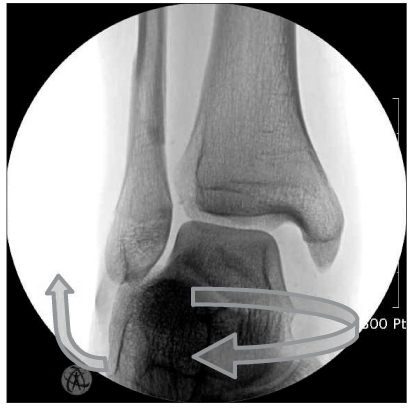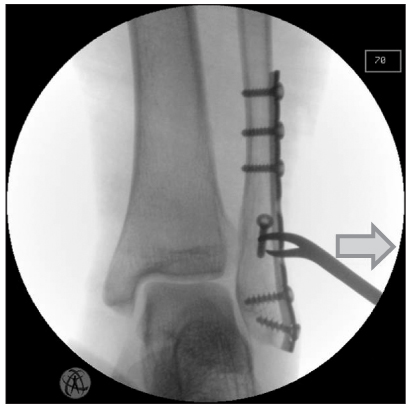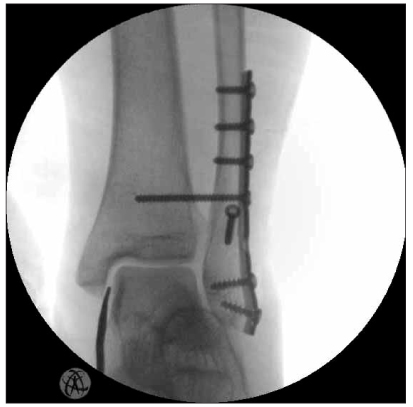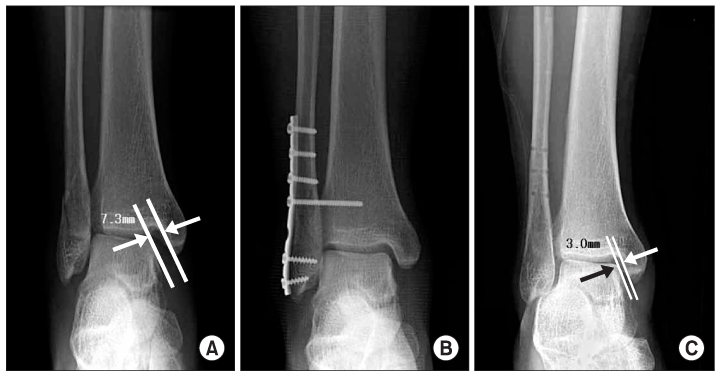J Korean Orthop Assoc.
2010 Jun;45(3):210-215. 10.4055/jkoa.2010.45.3.210.
Treatment of Lateral Malleolar Fracture Associated with Disruption of the Deltoid Ligament
- Affiliations
-
- 1Department of Orthopedic Surgery, Kwangmyung Sung-Ae Hospital, Gwangmyeong, Korea. khg0623@hanmail.net
- 2Department of Orthopedic Surgery, Sung-Ae General Hospital, Seoul, Korea.
- KMID: 2185520
- DOI: http://doi.org/10.4055/jkoa.2010.45.3.210
Abstract
- PURPOSE
To evaluate the necessity for repair of associated deltoid ligament rupture in lateral malleolar fracture. MATERIALS AND
METHODS
Twenty of twenty-five patients were evaluated. Each received surgical treatment without repair of the ruptured deltoid ligament. We found that the medial clear space was widened more than 5 mm in intraoperative stress tests which had been done between May 2003 and June 2008. We did follow-up on these patients for more than 1 year after surgery. At the final follow-up, radiologic and clinical assessment were evaluated on plain X-ray and according to Olerud Molander ankle scores.
RESULTS
Open reduction and internal fixation of the lateral malleolar was done in all cases and an additional transfixation screw was needed in 17 patients who had concurrent syndesmotic disruption. Average medial clear space widening before surgery was 9.28 mm (7.0-17.14 mm), at final follow-up time it was 3.43 mm (2.9-5.28 mm). And there were 8 (40%) good, 10 (50%) fair and 2 (10%) poor ratings on radiologic evaluation, but the mean clinical score was 93.75, with 17 (85%) being excellent, 2 (10%) good and 1 (5%) fair on clinical evaluation.
CONCLUSION
In the treatment of lateral malleolus fracture associated with disruption of the deltoid ligament, satisfactory clinical results could be obtained including lateral joint stability, with accurate anatomical reduction and internal fixation of the lateral malleolus and distal tibio-fibular joints. Medial joint stability could be obtained without deltoid ligament repair.
Figure
Cited by 1 articles
-
The Risk Factors Associated with Nonunion after Surgical Treatment for Distal Fibular Fractures
Jun Young Lee, Kwi Youn Choi, Sinwook Kang, Kang Yeol Ko
J Korean Foot Ankle Soc. 2018;22(3):95-99. doi: 10.14193/jkfas.2018.22.3.95.
Reference
-
1. Lauge-Hansen N. Fracture of the ankle II. Combined experimental-surgical and experimental-roentgenologic investigation. Arch Surg. 1950. 60:957–959.2. Clayton ML, Miles JS, Abdulla M. Experimental investigations of ligamentous healing. Clin Orthop Relat Res. 1968. 61:146–153.
Article3. Pankovich AM. Maisonneuve fracture of the fibula. J Bone Joint Surg Am. 1976. 58:337–342.
Article4. Solonen KA, Lauttamus L. Operative treatment of ankle fractures. Acta Orthop Scand. 1968. 39:223–237.
Article5. McLaughlin HL. McLaughlin HL, editor. Injuries of the ankle. 1959. Philadelphia: WB Saunders;333–362.6. Ramsey PL, Hamilton W. Changes in tibiotalar area of contact caused by lateral talar shift. J Bone Joint Surg Am. 1976. 58:356–357.
Article7. Harper MC. Deltoid ligaments: An anatomical evaluation of function. Foot Ankle. 1987. 8:19–22.8. Stromsoe K, Hoqevold HE, Skjeldal S, Alho A. The repair of a ruptured deltoid ligament is not necessary in ankle fractures. J Bone Joint Surg Br. 1995. 77:920–921.
Article9. James D, Michelson MD. Current concepts review: Fractures about ankle. J Bone Joint Surg Am. 1995. 77:142–152.10. Baird RA, Jackson ST. Fractures of distal part of the fibula with associated disruption of the deltoid ligament Treatment without repair of the deltoid ligament. J Bone Joint Surg Am. 1987. 69:1346–1352.11. Yablon IG, Haller FG, Shouse L. The key role of the lateral malleolus in displaced fractures of the ankle. J Bone Joint Surg Am. 1977. 59:169–173.
Article12. Yablon IG, Leach RE. Reconstruction of malunited fractures of the lateral malleolus. J Bone Joint Surg Am. 1989. 71:521–527.
Article13. Park SW, Lee SH, Park JW, Oh KJ. Treatment of the deltoid ligament injury in ankle fractures combined with distal tibiofi bular diastasis. J Korean Orthop Assoc. 1999. 34:403–409.14. De Souza LJ, Gustilo RB, Meyer TJ. Results of operative treatment of displaced external rotation-abduction fractures of the ankle. J Bone Joint Surg Am. 1985. 67:1066–1074.
Article15. Park SS, Kubiak EN, Egol KA, Kummer F, Koval KJ. Stress radiographs after ankle fracture: the effect of ankle position and deltoid ligament status on medial clear space measurements. J Orthop Trauma. 2006. 20:11–18.16. Schuberth JM, Collman DR, Rush SM, Ford LA. Deltoid ligament integrity in lateral malleolar fractures: a comparative analysis of arthroscopic and radiographic assessments. J Foot Ankle Surg. 2004. 43:20–29.
Article17. Stiehl JB. Ankle fractures with diastasis. Instr Course Lect. 1990. 39:95–103.18. Van den Beckerom MP, Mutsaerts EL, van Dijk CN. Evaluation of the integrity of the deltoid ligament in supination external rotation ankle fractures: a systematic review of the literature. Arch Orthop Trauma Surg. 2009. 129:227–235.
Article19. Pettrone FA, Gail M, Pee D, Fitzpatrick T, Van Herpe LB. Quantitative criteria for prediction of the results after displaced fracture of the ankle. J Bone Joint Surg Am. 1983. 65:667–677.
Article20. Ebraheim NA, Elgafy H, Padanilam T. Syndesmotic disruption in low fibular fractures associated with deltoid ligament injury. Clin Orthop Relat Res. 2003. (409):260–267.
Article21. Ponzer S, Nåsell H, Bergman B, Törnkvist H. Functional outcome and quality of life in patients with type B ankle fractures: a two-year follow-up study. J Orthop Trauma. 1999. 13:363–368.
Article22. Cedell CA. Outward rotation-supination injuries of the ankle. Clin Orthop Relat Res. 1965. 42:97–100.23. Leeds HC, Ehrlich MG. Instability of the distal tibiofibular syndesmosis after bimalleolar and trimalleolar ankle fractures. J Bone Joint Surg Am. 1984. 66:490–503.
Article24. Slonen KA, Lauttamus L. Operative treatment of ankle fractures. Acta Orthop Scand. 1968. 39:223–237.25. Borden SD, Labropoulos PA, McCowin P, Lestini WF, Hurwitz SR. Mechanical considerations for the syndesmosis screw. A cadaver study. J Bone Joint Surg Am. 1989. 71:1548–1555.26. Yamaguchi K, Martin CH, Borden SD, Labropoulos PA. Operative treatment of syndesmotic disruptions without use of a syndesmotic screw: a prospective clinical study. Foot Ankle Int. 1994. 15:407–414.
Article27. Monk CJ. Injuries of the tibio-fibular ligaments. J Bone Joint Surg Br. 1969. 51:330–337.
Article28. Bonin JG. Injury to the ligaments of the ankle. J Bone Joint Surg Br. 1965. 47:609–611.
- Full Text Links
- Actions
-
Cited
- CITED
-
- Close
- Share
- Similar articles
-
- A Clinical Study of Disruption of the Deltoid Ligament Associated with Fractures of Distal Fibula
- Diagnosis and Management of Suspected Deltoid Injury
- The Necessity of Deltoid Ligament Repair in Lateral Malleolar Fracture Combined with Medial Clear Space Widening
- Assessment of the Stability of the Isolated Lateral Malleolar Fracture
- A Clinical Study of the Treatment of Ruptures of Deltoid Ligament Associated with Fracture of Distal Part of Fibula






